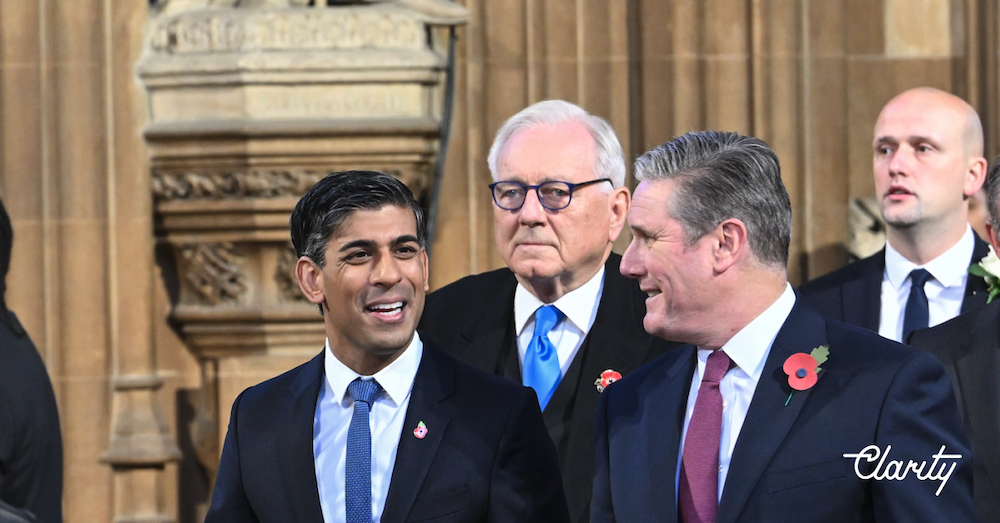‘Captain Caution’ vs ‘The Kitchen Sink’: UK party election manifestos compared



By Kris Hopkins
Senior Political Advisor
The battle for No.10 (political leadership of the UK) has as of June 2024 hit the halfway point following the launch of the UK parties’ election manifestos.
Notable for being particularly dense documents from both major political parties (the Labour and Conservative parties), the Conservatives opted for Silverstone, the iconic motor racing circuit, as the location of their ‘everything and the kitchen sink’ manifesto launch.
There weren’t that many surprises in their proposals, but it was clear that Rishi Sunak (UK Prime Minister and Conservative party leader) was trying to appease all sides of his voter base. Labour opted to launch their manifesto in Manchester following a series of emotional speeches from Labour voters about how the Conservative government has let them down. Their manifesto has been described as a ‘Captain Caution’ document – trying to maintain their poll lead and ensure they form a new government.
Events preceding the manifesto launch were shaped by Sunak’s earlier – and now infamous – decision to depart early from the D-Day commemorations. This was seen as not only disrespectful to veterans and their families, but it also confirmed his critics' claims that he doesn’t have a political instinct. Why would you return to do yet another TV interview, especially one admitting that ‘not having Sky TV’ was your biggest childhood sacrifice, rather than stand with world leaders remembering the day when so many gave their lives to secure our democracy?
When you are 20 points behind and successfully damage your campaign further, you might understand why the Defence Secretary Grant Shapps would go out and warn of a Labour “supermajority”. Talking to Conservative candidates, they say there is still no love for either of the two main parties on the doorstep. So, Sunak may be on the ropes, but he has his plan. He will repeat endlessly to the electorate the claim that Labour will hand them a £2,094 tax rise, and hope that the polls begin to tighten in the coming weeks.
One of the electoral consequences of the D-Day mistake is the potential impact on the Conservatives’ key demographic, the over-50s. Many in that over-50s Tory base had already indicated that their ‘cross in the box’ was now hovering over their alternative candidate from the Reform UK party – after Sunak failed to “stop the small boats”.
Nigel Farage, the Reform UK party leader, went to the D-Day commemorations, stayed for the duration, and paid his own expenses. He was soon on the TV claiming Sunak was “not a patriotic leader” and following the launch of his ‘Contract’ with the UK electorate, some polls put him ahead of Sunak. Conservative candidates are now dropping Sunak from their election leaflets, and at least one is using a Farage photo instead. In sharp contrast, Kier Starmer’s (the Labour party’s leader) image appears 33 times in the Labour Manifesto.
In the Labour camp, it has been a dream start to the election, just about gaff-free, and this was reflected in the optimism which showed through in Starmer’s Manifesto launch speech. It’s a happy campaign and Starmer said he was “enjoying it”. He might be playing the part of ‘Captain Caution’; the 131 pages of the Manifesto do not include anything that has not already been announced.
But when you are confident enough to include two “pantomimes”, a “Circus”, and “Rabbits from hats” in your launch event, all said with a smile, you could begin to see that illusive sense of ‘hope’ might be about to make a rare appearance in a UK General Election. If the first 886 words of the Labour manifesto are anything to go by, the UK should certainly expect a ‘change’ in direction come July 5th with Starmer and Labour still polling strongly.
OK, there is still a long way to go and Labour still hasn’t been expressly challenged on what it will do, and how it will pay for it, bar from Sky News’ Beth Rigby, who expertly scrutinised both leaders last week. Neither appeared to do particularly well but Sunak came off worse.
Is the Tory brand so badly damaged that, even if the heat is turned up on Labour, it would make little difference to the election outcome? A normal general election campaign is four weeks long. With just over two weeks left to run, there are still opportunities for more mistakes, and more indicators for the electorate to read.
No economic growth in April, and a declining employment market, can’t help the Tory cause either, especially when Labour claim that ‘wealth creation’ is their key priority. Phrases like “mission-driven” and “growth is at our core” are now embedded into every Labour utterance.
With the Euros now in full swing and following a lacklustre performance from England on Sunday, will the football gods look down favourably on footy-mad Rishi? The outlook is looking bleak.
Clarity supports organisations from all areas of industry, but specifically has a wealth of expertise in tech and health. Let’s take a look at what the manifestos mean for those sectors.
Both the Conservative and Labour manifestos were keen to highlight the importance of technology and infrastructure development for the economy, and for society more broadly.
Although the Conservatives promised to accelerate timelines and reduce costs for consented projects by simplifying the planning system and ending “frivolous” legal challenges, Labour went all in, promising to introduce a ten-year infrastructure strategy, update planning policy, and create a new National Infrastructure and Service Transformation Authority.
Gigabit broadband and 5G mobile network rollout has been a success story for the current government, and therefore the Conservatives would continue this work. Labour, however, promises a “renewed push” in these areas.
In terms of cybersecurity, while both recognise its importance to national security – with Labour promising to launch a Strategic Defence Review, and the Conservatives placing cyber defence within their new national service programme – there was little in the way of specific policy recommendations.
While many of these policies are reflections of the other, when it comes to technology and infrastructure, Labour's plans appear bigger and broader.
All manifestos published this week highlighted the importance of further investment into the NHS (National Health Service) and its workforce. Labour focused on tackling the waiting lists, whilst the Conservatives emphasised growing the size of the workforce.
The Conservatives came under heat from the health sector after pledging to cut the number of NHS managers by 5,500. Though this grabbed headlines, the health sector made it clear that the solution may not be that simple, pushing more paperwork to clinicians, and undermining the vital role effective managers play in increasing productivity within the system.
Innovation and access to technology was highlighted in both manifestos, with the Conservatives pledging to implement a new Medtech pathway to allow cost-effective medical technology to be rapidly adopted. The Labour Manifesto in turn pledged to introduce a new plan for procurement, coupled with reformed incentives to drive innovation and faster approval of technologies and medicines. Both manifestos also pledged to go through with the New Hospitals Programme, aiming to have 40 new hospitals built across England.
The Conservative manifesto more broadly focused on going ahead with announced government health initiatives like the Tobacco and Vapes Bill, implementing the Major Conditions Strategy, building more Community Diagnostic Centres and taking forward the Social Care reforms introduced in the “People at the Heart of Care” whitepaper. Labour in turn focused on investing in AI for diagnostics, doubling CT and MRI scanners, and delivering an extra two million operations and appointments a year using spare private sector capacity.
Are you interested in learning more about how the upcoming election could affect your brand and customers, or do you want to meet with one of our UK public affairs specialists to learn what we can do for your business? Reach out today.
Photo credit: UK Parliament/ Jessica Taylor, Maria Unger, Andy Bailey
Share this
Receive all the latest news, events, and insights on B2B tech, marketing, and communications with Clarity’s free monthly newsletter.
As a consultancy, our full-funnel marketing and communications solutions are designed to fearlessly deliver business results across multiple industries and service areas.

Looking for a partner to help you reach your goals? We’d love to hear from you.